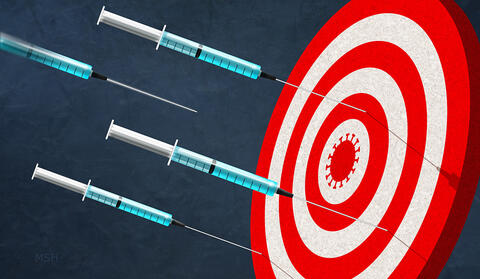
One of the biggest challenges facing scientists, public health experts, and society itself during the COVID-19 crisis is the need to develop an effective vaccine for the virus that causes the disease.
Researchers around the world are racing to develop just such a vaccine. Even so, scientific and medical authorities say it may be at least a year before one is ready.
Yale’s David Spiegel, professor of chemistry and pharmacology, discussed some of the approaches being explored for a vaccine. Interview condensed and edited.
How do vaccines typically work in the human body?
It’s fairly straightforward. All you’re doing is exposing the body to various proteins, carbohydrates, and other molecules that are present in the virus. But you’re doing it in a setting that is non-pathological. That is, the vaccine is recognized by your immune system, and it educates your immune system about proteins from the offending virus. This enables your immune system to mount a response with antibodies or T-cells when the actual pathogen comes along.

How many COVID-19 vaccines are being developed?
I don’t think anyone can give an exact answer right now. I’m sure there are a lot of small biotech companies that are working on this, as well as large pharmaceutical companies that tend to work on things and not publicize them. But I would say there are nine or 10 highly publicized vaccine approaches being developed, and nearly as many drug therapies being developed.
Which ones seem most promising?
So many of these vaccine approaches are exciting. One that has received a serious amount of attention is being developed by the Boston biotech company Moderna and the National Institutes of Health. It’s an mRNA vaccine. This approach involves the blueprints for virus proteins, which can be introduced into human cells to start that education process for the immune system. You’re not actually introducing the viral proteins themselves, just the template for those proteins.
RNA vaccines are probably very safe to administer and very quick to develop and scale up. This is why, within a few weeks of COVID-19 becoming a public threat, Moderna already had a candidate that it could test in people. That is the upside. The downside is that no mRNA vaccine has ever been approved by the U.S. Food and Drug Administration for humans. There’s an inherent risk from having an entirely different approach that hasn’t been validated previously.
Another vaccine approach is called hyperimmune globulin, also known as the “blood bag” option. Researchers at Johns Hopkins University are attempting this approach.
Here’s how it would work. When a person is infected and successfully fights off the virus with proteins called antibodies, you can take plasma from that person and create a serum with a high concentration of the right antibodies. This is a very old approach, utilized on a large number of conditions. Very well validated. The downside is that the supply of effective hyperimmune globulin is going to be extremely limited, due to the limited number of suitable antibody donors, among other factors. In my opinion, it’s a great short-term measure, but it may not be a sustainable, scalable approach.
There has been a galvanization of the science community.
Everyone I know is focused on this pandemic, so anything is possible.
Recent news reports indicate that COVID-19 has been slow to mutate, which may give a potential vaccine more staying power. Do you agree?
We have a lot more to learn about this virus. Theoretically, if the mutation rate is slow, then the ability of the virus to mutate around a vaccine would also be slow — and population-level immunity would be high. But there may be other immune system mechanisms that we don’t understand. If antibody levels after vaccination don’t remain high over a long period of time, for example, then immunity goes down and reinfection is possible.
What is the likelihood for an effective vaccine in the next year?
There has been a galvanization of the science community. Everyone I know is focused on this pandemic, so anything is possible. I’m hopeful that something will turn up even faster than a year from now. But I should point out that the one-year timeframe, although it may not feel fast enough for many of us, including myself, it’s actually quite fast for bringing any kind of novel therapeutic to people.
Some things cannot be sped up. Enrolling patients in a trial takes time. Obtaining materials for a clinical trial takes time. But with so many approaches being explored, I think something is going to turn up and be successful.
Media Contact
Fred Mamoun: fred.mamoun@yale.edu, 203-436-2643